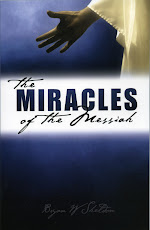Almost two millennia ago a group of Jewish leaders plotted the execution of a young man, Jesus of Nazareth. The death of this young Jew has had implications for the whole of humankind ever since. This blog is designed to re-examine the events of those days and place them in the culture of the period. In addition, we will allow ourselves the liberty to write on any current customs if we feel they throw light on the Scriptures.
We begin by examining the Messianic credentials of Jesus of Nazareth.
 If Jesus of Nazareth presented Himself to the nation of Israel as Messiah, what kind of credentials should He offer to be accepted by the members of the ruling class of the nation, especially the Sanhedrin? It appears that the template for a Messiah had been established many centuries earlier by Moses, the prophet who was God's instrument in creating the nation and establishing the principles by which it would be governed. Jesus would have to perform miracles - and not just any miracles -for there had been miracle workers before Him. He would have to perform particular miracles - similar to those that Moses performed as attesting signs when he was called to lead the nation. Moreover, the miracles that Moses performed for the elders of Israel were not some randam authenticating signs but were themselves related to the essential basic problem that humanity faced - the issue of the fall of Adam in the Garden of Eden and the events associated with it. The circumstances of Adam's transgression in the Garden of Eden dictated that God's Messiah would have to demonstrate that He had the power to deliver from the effects of Adam's disobedience. Namely:
If Jesus of Nazareth presented Himself to the nation of Israel as Messiah, what kind of credentials should He offer to be accepted by the members of the ruling class of the nation, especially the Sanhedrin? It appears that the template for a Messiah had been established many centuries earlier by Moses, the prophet who was God's instrument in creating the nation and establishing the principles by which it would be governed. Jesus would have to perform miracles - and not just any miracles -for there had been miracle workers before Him. He would have to perform particular miracles - similar to those that Moses performed as attesting signs when he was called to lead the nation. Moreover, the miracles that Moses performed for the elders of Israel were not some randam authenticating signs but were themselves related to the essential basic problem that humanity faced - the issue of the fall of Adam in the Garden of Eden and the events associated with it. The circumstances of Adam's transgression in the Garden of Eden dictated that God's Messiah would have to demonstrate that He had the power to deliver from the effects of Adam's disobedience. Namely:1. He would obtain victory over Satan where Adam knew defeat.
2. He would provide forgiveness of sin to counteract the judgement that resulted fell on Adam and his posterity.
These would come at a cost as the key Genesis 3:15 prophecy indicated. The seed of the woman would crush the serpent's head, but the serpent would bruise the heel of the seed of the woman. In other words, the Messiah would inflict a mortal wound on the Serpent, but would be sorely wounded Himself. The design of the Messianic miracles, therefore, had to symbolise:
(1) the initial subjugation of Satan
(2) authority to forgive sin
(3) the ultimate defeat of Satan (although at personal cost to the Messiah)
God gave Moses power to perform such authenicating miracles as were needed to convince the elders of Israel that YHWH had commissioned him to deliver them from slavery. These miracles were later reinforced by other additional signs when God dealt with Pharaoh's hard-hearted opposition, and when He miraculously sustained the nation through the inhospitable territory of the Sinai desert.
The Sanhedrin expected Messianic claimants to perform miracles of the calibre of the primary attesting signs of Moses as well as other miraculous works.
While the ministry of Moses was accredited by miracles that had the symbolism of future truth (they were a type of future reality), the signs authenticating the ministry of the Redeemer of Israel had to be of the same character but much more. The Messiah's miracles were the anti-type, the reality of that which had been fore-shadowed. It was not enough that the miracles should imply that He was more powerful than the Devil, they should demonstrate the impotence of Satan in His presence and be part of the victory. His signs should not simply symbolise the forgiveness of sin; they should display and confirm His authority to forgive sin.
Against thsi dark background the miraculous ministry of the Messiah must be life-imparting, life-affirming and life-improving. The result of His ministry must be: "in Messiah all shall be made alive" (1 Cor.15:22).
Next time: An examination of the first primary attesting sign.





No comments:
Post a Comment